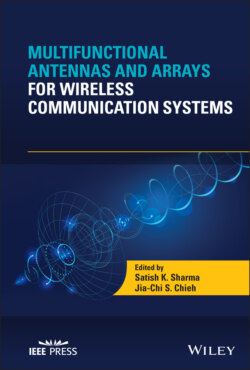Читать книгу Multifunctional Antennas and Arrays for Wireless Communication Systems - Группа авторов - Страница 17
1.4 Antenna Types
ОглавлениеVarious antennas that find use in wireless communication systems can be classified in many ways. Antenna geometry of four selected antennas is shown in Figure 1.2. Figure 1.2a shows a well‐known bow‐tie planar antenna that is known for wideband operation with omnidirectional radiation pattern performance. A planar inverted F‐antenna (PIFA) is shown in Figure 1.2b which has been known to provide single and multi‐band operation based on suitable dimension of the radiating structures and feeding mechanism. It also offers omnidirectional radiation patterns. Figure 1.2c shows a quasi‐Yagi planar antenna which offers end‐fire directional radiation patterns. Similarly, Figure 1.2d shows a stepped Vivaldi planar antenna which is known for its extremely wideband antenna performance.
The antenna performance can be characterized using impedance matching and radiation patterns. One example is shown in Figure 1.3. Figure 1.3a shows reflection coefficient magnitude versus frequency and Figure 1.3b shows 3D gain radiation patterns of an antenna. There are numerous full‐wave analysis tools, also called Maxwell Solvers, which provide accurate simulation and analysis results for an antenna. One such tool is Ansys high‐frequency structure simulator (HFSS) which has been used to generate these impedance matching and radiation pattern.
Figure 1.2 Some antenna types generated through Antenna Design Kit in Ansys Electronic Package.
